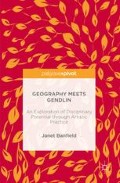Abstract
Chapter 7 contains a self-critical evaluation of the application of methods informed by Eugene Gendlin’s techniques within geographical research. Banfield identifies and discusses potential shortcomings in methodological choices and characterizes the research design itself in Gendlinian terms. On this basis, she constructively reframes two potentially conflicting aspects of the research design as complementary rather than contradictory, encouraging further investigation of and through such research designs. She also explores the implications for ongoing methodological innovation, both within and beyond non-representational geography, arising from this discussion and reinforces calls for individually tailored research designs. Through this critical evaluation, Banfield underlines the potential contribution that Gendlin’s work can make to geography.
Access this chapter
Tax calculation will be finalised at checkout
Purchases are for personal use only
References
Aziz-Zadeh, Lisa & Ivry, Richard B 2009 The human mirror neuron system and embodied representations. in: Sternad, D (ed.) Progress in motor control. Springer, New York; London 355–376
Banfield, Janet 2014 Towards a non-representational geography of artistic practice. Unpublished doctoral thesis, University of Oxford, Forthcoming online: https://ora.ox.ac.uk:443/objects/uuid:dd12e1c4-f222-435b-adc0-c1bb68e4f4ac
Banfield, Janet 2016a Knowing between: generating boundary understanding through discordant situations in geographic-artistic research. Cultural Geographies, 23 459–473
Banks, Marcus 2007 Using visual data in qualitative research. SAGE, Los Angeles; London
Calvo-Merino, B, Glaser, DE, Grezes, J, Passingham, RE & Haggard, P 2005 Action observation and acquired motor skills: an fMRI study with expert dancers. Cerebral Cortex 15 1243–1249
Clough, Patricia T 2010 Afterword: The future of affect studies. Body and Society 16 222–230
Cranny-Francis, Anne 2009 Touching film: the embodied practice and politics of film viewing and filmmaking. Senses and Society 4 163–178
Hawkins, Harriet 2015 Creative geographic methods: knowing, representing, intervening. On composing place and page. Cultural Geographies 22 247–268
Howes, David 2006 Charting the sensorial revolution. Senses and Society 1 113–128
Iacoboni, Marco 2009 The problem of other minds is not a problem: mirror neurons and intersubjectivity. in: Pineda, JA (ed.) Mirror neuron systems. Humana Press, New York 121–133
Knoblauch, Hubert; Schnetter, Bernt & Raab, Jürgen 2006 Video analysis: methodology and methods: qualitative audiovisual data analysis in sociology, 3rd edition. Lang, Frankfurt; Oxford
Laurier, Eric & Philo, Chris 2012 Natural problems of naturalistic video data. in: Knoblauch, H, Schnetter, B & Raab, J (eds.) Video analysis: methodology and methods: qualitative audiovisual data analysis in sociology, 3rd edition. Lang, Frankfurt; Oxford 181–190
Merchant, Stephanie 2011 The body and the senses: Visual methods, videography and the submarine sensorium. Body and Society 17 53–72
Rose, Gillian 2003 On the need to ask how, exactly, is geography “visual”? Antipode 35 212–221
Winkielman, Piotr; Niedenthal, Paula M & Oberman, Lindsay M 2009 Embodied perspective on emotion-cognition interactions. in: Pineda, J A (ed.) Mirror neuron systems. Humana Press, New York 235–257
Author information
Authors and Affiliations
Copyright information
© 2016 The Author(s)
About this chapter
Cite this chapter
Banfield, J. (2016). Critiquing Explicatory Techniques. In: Geography Meets Gendlin. Palgrave Pivot, New York. https://doi.org/10.1057/978-1-137-60440-8_7
Download citation
DOI: https://doi.org/10.1057/978-1-137-60440-8_7
Published:
Publisher Name: Palgrave Pivot, New York
Print ISBN: 978-1-137-60439-2
Online ISBN: 978-1-137-60440-8
eBook Packages: Social SciencesSocial Sciences (R0)

